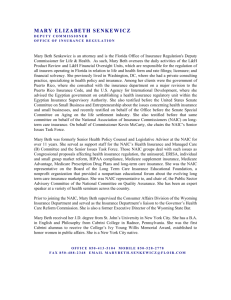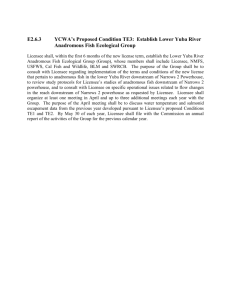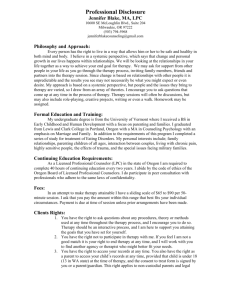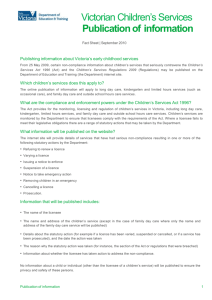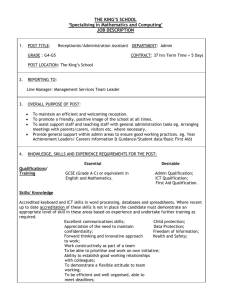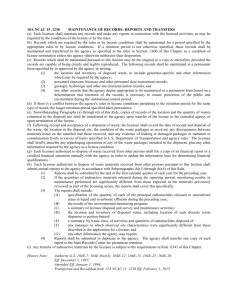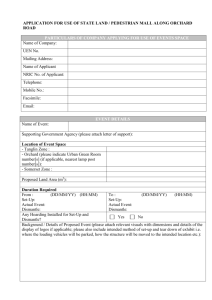Standards for Safeguarding Customer Information Model Regulation
advertisement
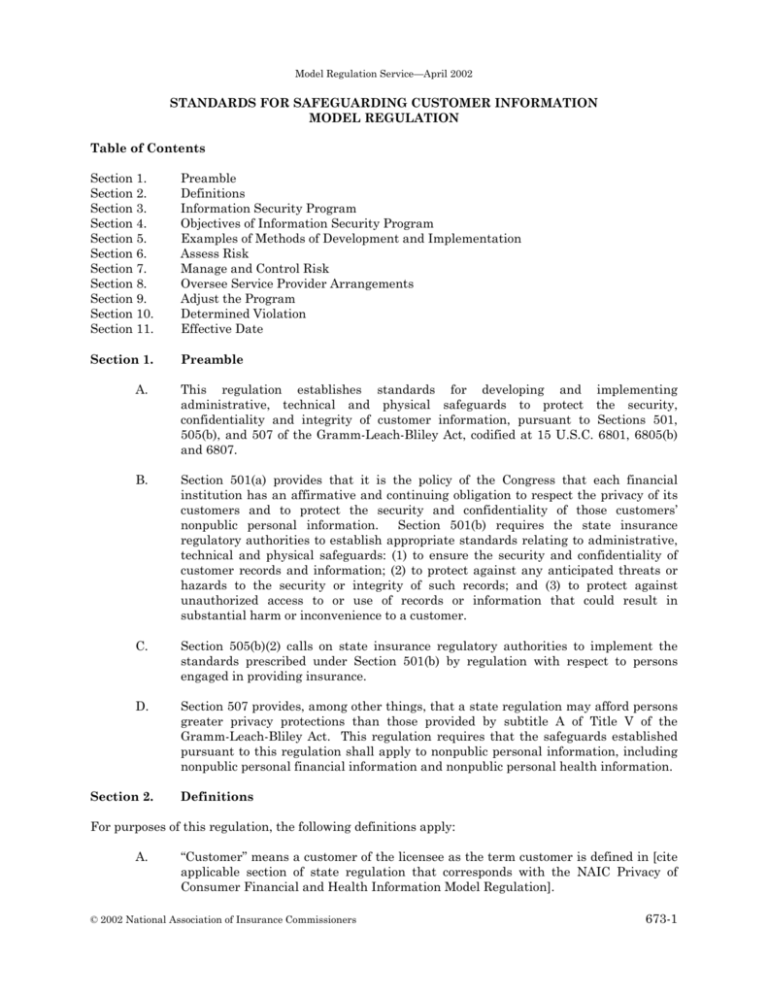
Model Regulation Service—April 2002 STANDARDS FOR SAFEGUARDING CUSTOMER INFORMATION MODEL REGULATION Table of Contents Section 1. Section 2. Section 3. Section 4. Section 5. Section 6. Section 7. Section 8. Section 9. Section 10. Section 11. Preamble Definitions Information Security Program Objectives of Information Security Program Examples of Methods of Development and Implementation Assess Risk Manage and Control Risk Oversee Service Provider Arrangements Adjust the Program Determined Violation Effective Date Section 1. Preamble A. This regulation establishes standards for developing and implementing administrative, technical and physical safeguards to protect the security, confidentiality and integrity of customer information, pursuant to Sections 501, 505(b), and 507 of the Gramm-Leach-Bliley Act, codified at 15 U.S.C. 6801, 6805(b) and 6807. B. Section 501(a) provides that it is the policy of the Congress that each financial institution has an affirmative and continuing obligation to respect the privacy of its customers and to protect the security and confidentiality of those customers’ nonpublic personal information. Section 501(b) requires the state insurance regulatory authorities to establish appropriate standards relating to administrative, technical and physical safeguards: (1) to ensure the security and confidentiality of customer records and information; (2) to protect against any anticipated threats or hazards to the security or integrity of such records; and (3) to protect against unauthorized access to or use of records or information that could result in substantial harm or inconvenience to a customer. C. Section 505(b)(2) calls on state insurance regulatory authorities to implement the standards prescribed under Section 501(b) by regulation with respect to persons engaged in providing insurance. D. Section 507 provides, among other things, that a state regulation may afford persons greater privacy protections than those provided by subtitle A of Title V of the Gramm-Leach-Bliley Act. This regulation requires that the safeguards established pursuant to this regulation shall apply to nonpublic personal information, including nonpublic personal financial information and nonpublic personal health information. Section 2. Definitions For purposes of this regulation, the following definitions apply: A. “Customer” means a customer of the licensee as the term customer is defined in [cite applicable section of state regulation that corresponds with the NAIC Privacy of Consumer Financial and Health Information Model Regulation]. © 2002 National Association of Insurance Commissioners 673-1 Standards for Safeguarding Customer Information Model Regulation B. “Customer information” means nonpublic personal information as defined in Section [cite applicable section of state regulation that corresponds with Section 4S of the NAIC Privacy of Consumer Financial and Health Information Model Regulation] about a customer, whether in paper, electronic or other form, that is maintained by or on behalf of the licensee. C. “Customer information systems” means the electronic or physical methods used to access, collect, store, use, transmit, protect or dispose of customer information. D. “Licensee” means a licensee as that term is defined in Section [cite applicable section of state regulation that corresponds with Section 4Q of the NAIC Privacy of Consumer Financial and Health Information Model Regulation], except that “licensee” shall not include: a purchasing group; or an unauthorized insurer in regard to the excess line business conducted pursuant to [cite applicable regulation or section of state insurance law]. Drafting Note: Service contract providers and extended warranty providers are “licensees” under the insurance laws of many states. Regulators should consider whether they wish to subject these entities to the requirements of this regulation. E. Section 3. “Service provider” means a person that maintains, processes or otherwise is permitted access to customer information through its provision of services directly to the licensee. Information Security Program Each licensee shall implement a comprehensive written information security program that includes administrative, technical and physical safeguards for the protection of customer information. The administrative, technical and physical safeguards included in the information security program shall be appropriate to the size and complexity of the licensee and the nature and scope of its activities. Section 4. Objectives of Information Security Program A licensee’s information security program shall be designed to: A. Ensure the security and confidentiality of customer information; B. Protect against any anticipated threats or hazards to the security or integrity of the information; and C. Protect against unauthorized access to or use of the information that could result in substantial harm or inconvenience to any customer. Section 5. Examples of Methods of Development and Implementation The actions and procedures described in Sections 6 through 9 of this regulation are examples of methods of implementation of the requirements of Sections 3 and 4 of this regulation. These examples are non-exclusive illustrations of actions and procedures that licensees may follow to implement Sections 3 and 4 of this regulation. 673-2 © 2002 National Association of Insurance Commissioners Model Regulation Service—April 2002 Section 6. Assess Risk The licensee: A. Identifies reasonably foreseeable internal or external threats that could result in unauthorized disclosure, misuse, alteration or destruction of customer information or customer information systems; B. Assesses the likelihood and potential damage of these threats, taking into consideration the sensitivity of customer information; and C. Assesses the sufficiency of policies, procedures, customer information systems and other safeguards in place to control risks. Section 7. Manage and Control Risk The licensee: A. Designs its information security program to control the identified risks, commensurate with the sensitivity of the information, as well as the complexity and scope of the licensee’s activities; B. Trains staff, as appropriate, to implement the licensee’s information security program; and C. Regularly tests or otherwise regularly monitors the key controls, systems and procedures of the information security program. The frequency and nature of these tests or other monitoring practices are determined by the licensee’s risk assessment. Section 8. Oversee Service Provider Arrangements The licensee: A. Exercises appropriate due diligence in selecting its service providers; and B. Requires its service providers to implement appropriate measures designed to meet the objectives of this regulation, and, where indicated by the licensee’s risk assessment, takes appropriate steps to confirm that its service providers have satisfied these obligations. Section 9. Adjust the Program The licensee monitors, evaluates and adjusts, as appropriate, the information security program light of any relevant changes in technology, the sensitivity of its customer information, internal external threats to information, and the licensee’s own changing business arrangements, such mergers and acquisitions, alliances and joint ventures, outsourcing arrangements and changes customer information systems. Section 10. in or as to Determined Violation Drafting Note: Cite Unfair Trade Practices Act or other applicable state law. © 2002 National Association of Insurance Commissioners 673-3 Standards for Safeguarding Customer Information Model Regulation Section 11. Effective Date Each licensee shall establish and implement an information security program, including appropriate policies and systems pursuant to this regulation by [insert date]. __________________________________________ Chronological Summary of Actions (all references are to the Proceedings of the NAIC). 2002 Proc. 1st Quarter 99, 101-103 (model adopted later is printed here). 2002 Proc. 2nd Quarter 7-8 (adopted). 673-4 © 2002 National Association of Insurance Commissioners Model Regulation Service—July 2014 STANDARDS FOR SAFEGUARDING CUSTOMER INFORMATION MODEL REGULATION These charts are intended to provide the readers with additional information to more easily access state statutes, regulations, bulletins or administrative rulings which are related to the NAIC model. Such guidance provides the reader with a starting point from which they may review how each state has addressed the model and the topic being covered. The NAIC Legal Division has reviewed each state’s activity in this area and has made an interpretation of adoption or related state activity based on the definitions listed below. The NAIC’s interpretation may or may not be shared by the individual states or by interested readers. This state page does not constitute a formal legal opinion by the NAIC staff on the provisions of state law and should not be relied upon as such. Every effort has been made to provide correct and accurate summaries to assist the reader in targeting useful information. For further details, the laws cited should be consulted. The NAIC attempts to provide current information; however, due to the timing of our publication production, the information provided may not reflect the most up to date status. Therefore, readers should consult state law for additional adoptions and subsequent bill status. © 2014 National Association of Insurance Commissioners ST-673-1 Model Regulation Service—July 2014 STANDARDS FOR SAFEGUARDING CUSTOMER INFORMATION MODEL REGULATION This page is intentionally left blank ST-673-2 © 2014 National Association of Insurance Commissioners Model Regulation Service—July 2014 STANDARDS FOR SAFEGUARDING CUSTOMER INFORMATION MODEL REGULATION KEY: MODEL ADOPTION: States that have citations identified in this column adopted the most recent version of the NAIC model in a substantially similar manner. This requires states to adopt the model in its entirety but does allow for variations in style and format. States that have adopted portions of the current NAIC model will be included in this column with an explanatory note. RELATED STATE ACTIVITY: States that have citations identified in this column have not adopted the most recent version of the NAIC model in a substantially similar manner. Examples of Related State Activity include but are not limited to: An older version of the NAIC model, legislation or regulation derived from other sources such as Bulletins and Administrative Rulings. NO CURRENT ACTIVITY: No state activity on the topic as of the date of the most recent update. This includes states that have repealed legislation as well as states that have never adopted legislation. NAIC MEMBER MODEL ADOPTION Alabama ALA. ADMIN. CODE r. 482-1-126 (2003). Alaska ALASKA ADMIN. CODE tit. 3, § 26.705 (2005). American Samoa NO CURRENT ACTIVITY Arizona ARIZ. ADMIN. CODE §§ 20-6-2101 to 20-6-2104 (2004). Arkansas ARK. CODE R. § 77 (2003). California CAL. CODE REGS. tit. 10, §§ 2689.12 to 2689.20 (2003). Colorado 6 COLO. CODE REGS. § 4-2 (2003). Connecticut CONN. AGENCIES REGS. §§ 38a-8-124 to 38a-8-126 (2003). Delaware 18 DEL. CODE REGS. § 905 (2002/2003). District of Columbia D.C. MUN. REGS. tit 26, §§ 3613 to 3620.1 (2003). Florida FLA. ADMIN. CODE ANN. r. 69O-128.030 to 69O-128.035 (2002). © 2014 National Association of Insurance Commissioners RELATED STATE ACTIVITY BULLETIN 1-2006 (2006). ST-673-3 Model Regulation Service—July 2014 STANDARDS FOR SAFEGUARDING CUSTOMER INFORMATION MODEL REGULATION NAIC MEMBER MODEL ADOPTION Georgia NO CURRENT ACTIVITY Guam NO CURRENT ACTIVITY Hawaii NO CURRENT ACTIVITY RELATED STATE ACTIVITY Idaho IDAHO CODE ANN. § 28-51-105 (2006/2014). Illinois ILL. ADMIN. CODE tit. 50, §§ 4003.10 to 4003.110 (2003). Indiana NO CURRENT ACTIVITY Iowa IOWA ADMIN. CODE r. 191-90.37 to 191-90.40 (2002) Kansas NO CURRENT ACTIVITY Kentucky 806 KY. ADMIN. REGS. 3:230 (2004). Louisiana NO CURRENT ACTIVITY Maine ME. CODE R. § 980 (2004). Maryland NO CURRENT ACTIVITY Massachusetts 201 MASS. CODE REGS. 17.00 to 17.05 (2008/2009). Michigan MICH. ADMIN. CODE r. 500.551 to 500.560 (2004). Minnesota MINN. STAT. §§ 60A.98 to 60A.982 (2005/2014). Mississippi NO CURRENT ACTIVITY Missouri MO. CODE REGS. ANN. tit. 20, § 100-6.110 (2003). Montana MONT. ADMIN. R. 6.6.7001 to 6.6.7019 (2005). ST-673-4 © 2014 National Association of Insurance Commissioners Model Regulation Service—July 2014 STANDARDS FOR SAFEGUARDING CUSTOMER INFORMATION MODEL REGULATION NAIC MEMBER MODEL ADOPTION Nebraska 210 NEB. ADMIN. CODE § 77 (2003). Nevada NO CURRENT ACTIVITY New Hampshire N.H. CODE ADMIN. R. ANN. INS. 3701.01 to 3711.01 (2004). New Jersey N.J. ADMIN. CODE §§ 11:1-44-1 to 11:1-44-9 (2004). New Mexico NO CURRENT ACTIVITY New York N.Y. COMP. CODES R. & REGS. tit. 11, §§ 421.0 to 421.10 (Regulation 173) (2002). North Carolina N.C. GEN. STAT. §§ 58-39-130 to 58-39-165 (2003). North Dakota N.D. ADMIN. CODE 45-14-02-01 to 45-14-02-03 (2004). Northern Marianas NO CURRENT ACTIVITY Ohio NO CURRENT ACTIVITY Oklahoma OKLA. ADMIN. CODE §§ 365:35-3-1 to 365:35-3-11 (2005). Oregon OR. ADMIN. R. 836-081-0100 to 836-081-0125 (2003). Pennsylvania 31 PA. CODE §§ 146c.1 to 146c.11 (2004). Puerto Rico NO CURRENT ACTIVITY Rhode Island 27-105 R.I. CODE R. §§ 1 to 12 (2005). South Carolina NO CURRENT ACTIVITY South Dakota S.D. ADMIN. R. §§ 20:06:45:20 to 20:06:45:26 (2003). © 2014 National Association of Insurance Commissioners RELATED STATE ACTIVITY ST-673-5 Model Regulation Service—July 2014 STANDARDS FOR SAFEGUARDING CUSTOMER INFORMATION MODEL REGULATION NAIC MEMBER MODEL ADOPTION Tennessee NO CURRENT ACTIVITY Texas NO CURRENT ACTIVITY Utah UTAH ADMIN. CODE r. 590-216-1 to 590-216-8 (2002/2012). Vermont VT. CODE R. IH-2002-3 (2003). Virgin Islands NO CURRENT ACTIVITY Virginia VA. CODE ANN. § 38.2-613.2 (2003) (portions of model). Washington NO CURRENT ACTIVITY West Virginia W. VA. CODE §§ 114-62-1 to 114-62-6 (2002). Wisconsin NO CURRENT ACTIVITY Wyoming WYO. CODE R. § 55 (2003). ST-673-6 RELATED STATE ACTIVITY Administrative Letter 2003-4 (2003). © 2014 National Association of Insurance Commissioners
